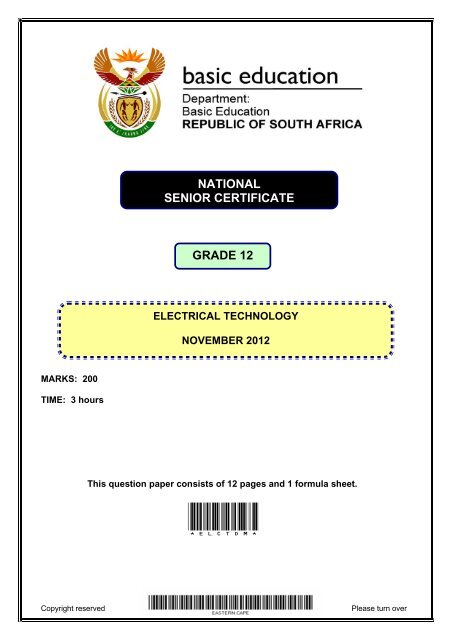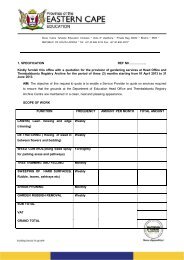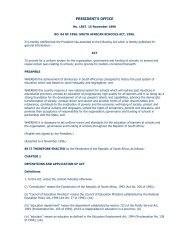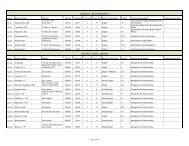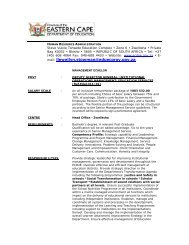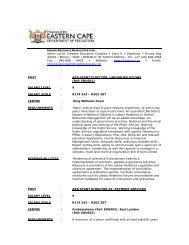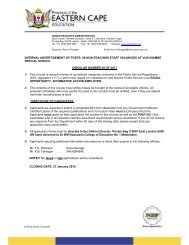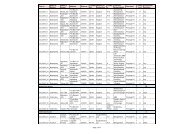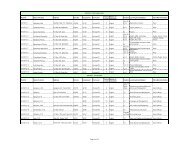Electrical Technology Nov 2012 Eng.pdf
Electrical Technology Nov 2012 Eng.pdf
Electrical Technology Nov 2012 Eng.pdf
Create successful ePaper yourself
Turn your PDF publications into a flip-book with our unique Google optimized e-Paper software.
GRAAD 12<br />
NATIONAL<br />
SENIOR CERTIFICATE<br />
GRADE 12<br />
ELECTRICAL TECHNOLOGY<br />
NOVEMBER <strong>2012</strong><br />
MARKS: 200<br />
TIME: 3 hours<br />
This question paper consists of 12 pages and 1 formula sheet.<br />
*ELCTDM*<br />
Copyright reserved<br />
Please turn over
<strong>Electrical</strong> <strong>Technology</strong> 2 DBE/<strong>Nov</strong>ember <strong>2012</strong><br />
NSC<br />
INSTRUCTIONS AND INFORMATION<br />
1.<br />
2.<br />
3.<br />
4.<br />
5.<br />
6.<br />
7.<br />
8.<br />
Answer ALL the questions.<br />
Sketches and diagrams must be large, neat and fully labelled.<br />
ALL calculations must be shown and must be correctly rounded off to TWO<br />
decimal places.<br />
Number the answers correctly according to the numbering system used in this<br />
question paper.<br />
Non-programmable calculators may be used.<br />
Show the units for all answers of calculations.<br />
A formula sheet is provided at the end of this question paper.<br />
Write neatly and legibly.<br />
Copyright reserved<br />
Please turn over
<strong>Electrical</strong> <strong>Technology</strong> 3 DBE/<strong>Nov</strong>ember <strong>2012</strong><br />
NSC<br />
QUESTION 1: TECHNOLOGY, SOCIETY AND THE ENVIRONMENT<br />
1.1 Coal is the primary source of energy used by South African power stations.<br />
1.1.1 Name and describe ONE negative impact the use of coal may have<br />
on the environment. (2)<br />
1.1.2 Give TWO reasons why coal is still used as an energy source even<br />
though it has a negative impact on the environment. (2)<br />
1.2 Name TWO skills that a successful entrepreneur should have. (2)<br />
1.3 The cellular phone is a technological development. Name and describe ONE<br />
benefit to society. (2)<br />
1.4 Describe how the term equal access to employment relates to electrical<br />
technology school leavers. (2)<br />
[10]<br />
QUESTION 2: TECHNOLOGICAL PROCESS<br />
2.1 Name the FOUR steps that are used in the technological process after a<br />
product has been identified. (4)<br />
2.2 Describe why it is necessary to use these steps in relation to the product. (2)<br />
2.3 Give FOUR reasons why it is necessary to make a prototype of a product<br />
before production of that product. (4)<br />
[10]<br />
QUESTION 3: OCCUPATIONAL HEALTH AND SAFETY<br />
3.1 State TWO unsafe acts that must not take place in an electrical technology<br />
workshop. (2)<br />
3.2 Explain why water may not be used to extinguish a fire caused by an<br />
electrical fault. (2)<br />
3.3 State TWO safety precautions that must be taken when using a multimeter to<br />
measure current in a circuit. (2)<br />
3.4 Give TWO reasons why good ventilation in an electrical technology workshop<br />
is important. (2)<br />
3.5 Describe why it is important to use tools with insulated handles when working<br />
on electrical circuits. (2)<br />
[10]<br />
Copyright reserved<br />
Please turn over
<strong>Electrical</strong> <strong>Technology</strong> 4 DBE/<strong>Nov</strong>ember <strong>2012</strong><br />
NSC<br />
QUESTION 4: THREE-PHASE AC GENERATION<br />
4.1 Indicate whether the reading on a voltmeter when measuring an AC voltage is<br />
a maximum value, average value or effective/rms value. (1)<br />
4.2 Define the term apparent power. (3)<br />
4.3 Explain what is meant by the term active current. (3)<br />
4.4 A three-phase balanced load is connected in delta. The phase voltage is<br />
240 V/50 Hz and the phase current is 10 A. If the power factor is 0,8,<br />
calculate the line current drawn at full load.<br />
Given:<br />
V p<br />
f<br />
I Ph<br />
Cos θ<br />
= 240 V<br />
= 50 Hz<br />
= 10 A<br />
= 0,8 (3)<br />
[10]<br />
QUESTION 5: RLC CIRCUITS<br />
5.1 Define the term capacitive reactance. (3)<br />
5.2 Explain why the brightness of a lamp when connected in series with an<br />
inductor will decrease when the frequency of the supply is increased. (3)<br />
5.3 The phasor diagram in FIGURE 5.1 indicates the current values<br />
flowing through the components of a parallel circuit connected across a<br />
240 V/50 Hz supply.<br />
Given:<br />
I C = 10 A<br />
I C = 10 A<br />
I R = 15 A<br />
I L = 15 A<br />
V = 240 V<br />
f = 50 Hz<br />
I L = 15 A<br />
I R = 15 A<br />
I T<br />
V T<br />
FIGURE 5.1: PHASOR DIAGRAM OF AN RLC PARALLEL CIRCUIT<br />
Calculate:<br />
5.3.1 The total current flow through the circuit (3)<br />
5.3.2 The inductive reactance (3)<br />
5.3.3 The inductance of the coil (3)<br />
Copyright reserved<br />
Please turn over
<strong>Electrical</strong> <strong>Technology</strong> 5 DBE/<strong>Nov</strong>ember <strong>2012</strong><br />
NSC<br />
5.4 The RC circuit in FIGURE 5.2 consists of a 30 ohm resistor and a<br />
147 microfarad capacitor connected across a 240 V/50 Hz supply.<br />
Given:<br />
R = 30 Ω C = 147 160 µF<br />
R = 30 Ω<br />
C = 147 µF<br />
V = 240 V<br />
f = 50 Hz<br />
I<br />
240 V/50 Hz<br />
FIGURE 5.2: RC CIRCUIT<br />
Calculate:<br />
5.4.1 The capacitive reactance (3)<br />
5.4.2 The impedance of the circuit (3)<br />
5.4.3 The current flow in the circuit (3)<br />
5.4.4 The phase angle (3)<br />
5.5 With reference to FIGURE 5.2, describe what would happen to the voltage<br />
across the resistor if the capacitance of the capacitor was increased. (3)<br />
[30]<br />
Copyright reserved<br />
Please turn over
<strong>Electrical</strong> <strong>Technology</strong> 6 DBE/<strong>Nov</strong>ember <strong>2012</strong><br />
NSC<br />
QUESTION 6: SWITCHING AND CONTROL CIRCUITS<br />
6.1 Draw a fully labelled symbol of a DIAC. (2)<br />
6.2 The diagram in FIGURE 6.1 shows the characteristic curve of a TRIAC.<br />
I<br />
Forward conduction<br />
-V<br />
V BO<br />
Gate<br />
pulse<br />
I L<br />
I H<br />
+V<br />
Reverse conduction<br />
I H<br />
I L<br />
Gate<br />
pulse<br />
V BO<br />
I<br />
FIGURE 6.1: CHARACTERISTIC CURVE OF A TRIAC<br />
6.2.1 Give ONE application of a TRIAC. (1)<br />
6.2.2 Draw a fully labelled symbol of a TRIAC. (3)<br />
6.2.3 Describe what happens to the TRIAC at the points labelled 'gate<br />
pulse'. (2)<br />
6.2.4 Describe what happens to the TRIAC if the voltage across it<br />
reaches V BO . (2)<br />
6.2.5 Explain what the value I H represents on the characteristic curve. (2)<br />
6.2.6 Explain what happens to the voltage across the TRIAC when it<br />
begins to conduct. (2)<br />
6.2.7 Name ONE advantage a TRIAC has over an SCR. (1)<br />
Copyright reserved<br />
Please turn over
<strong>Electrical</strong> <strong>Technology</strong> 7 DBE/<strong>Nov</strong>ember <strong>2012</strong><br />
NSC<br />
6.3 The diagram in FIGURE 6.2 shows a lamp-dimming circuit using an SCR.<br />
R 2<br />
V Supply<br />
R 1<br />
3<br />
1<br />
2<br />
SCR<br />
C<br />
D<br />
R Load<br />
FIGURE 6.2: LAMP-DIMMING CIRCUIT<br />
6.3.1 Label the SCR terminals numbered 1, 2 and 3. (3)<br />
6.3.2 Describe the function of R 1 in the circuit. (3)<br />
6.3.3 If the value of R 2 is increased, describe how this will affect the<br />
brightness of the lamp. (4)<br />
[25]<br />
QUESTION 7: AMPLIFIERS<br />
7.1 7.1.1 The standard circuit symbol for an op amp is shown in<br />
FIGURE 7.1. Label the numbers 1, 2 and 3. (3)<br />
7.1.2 Label 4 and 5 AND state their function.<br />
4<br />
2 _<br />
3<br />
1<br />
+<br />
5<br />
FIGURE 7.1: SYMBOL OF AN OP AMP (2)<br />
7.2 With reference to an op amp, explain the term feedback. (2)<br />
Copyright reserved<br />
Please turn over
<strong>Electrical</strong> <strong>Technology</strong> 8 DBE/<strong>Nov</strong>ember <strong>2012</strong><br />
NSC<br />
7.3 Draw the output wave forms of the op amp circuits below.<br />
7.3.1<br />
+<br />
_<br />
7.3.2<br />
FIGURE 7.2: OP AMP (2)<br />
+<br />
_<br />
FIGURE 7.3: OP AMP (2)<br />
7.4 Refer to FIGURE 7.4.<br />
R F<br />
R IN<br />
+<br />
V IN<br />
_<br />
V OUT<br />
FIGURE 7.4: OP AMP CIRCUIT<br />
0 V<br />
7.4.1 Name the circuit. (1)<br />
7.4.2 Draw input and output waveforms on the same axis. (2)<br />
7.4.3 Describe what will happen to the voltage gain of the circuit if R IN is<br />
increased. (3)<br />
7.4.4 If the resistive value of R IN and R F are the same, state what would<br />
happen to the phase and amplitude of the output. (2)<br />
Copyright reserved<br />
Please turn over
<strong>Electrical</strong> <strong>Technology</strong> 9 DBE/<strong>Nov</strong>ember <strong>2012</strong><br />
NSC<br />
7.5 In the amplification process the amplitude of the wave form changes. What<br />
happens to the frequency of the wave form? (1)<br />
7.6 Explain what effect the very high input impedance (close to infinity) of an<br />
op amp will have on the preceding circuit (circuit connected to the input of the<br />
op amp). (5)<br />
[25]<br />
QUESTION 8: THREE-PHASE TRANSFORMERS<br />
8.1 State ONE cause of overheating in a transformer. (1)<br />
8.2 Name the TWO types of circuits in a transformer. (2)<br />
8.3 Describe why the secondary winding of a transformer must be connected in<br />
star if the transformer is to supply both a domestic and an industrial load. (3)<br />
8.4 A 240 kVA three-phase transformer supplies power to a soccer stadium. The<br />
transformer is connected in delta-star. The input line voltage is 11 kV and the<br />
output line voltage is 415 V at a lagging power factor of 0,85.<br />
Given:<br />
S<br />
V L(p)<br />
V L(s)<br />
Cos θ<br />
= 240 kVA<br />
= 11 000 V<br />
= 415 V<br />
= 0,85<br />
Calculate:<br />
8.4.1 The secondary phase voltage (3)<br />
8.4.2 The current drawn from the supply by the transformer at full load (3)<br />
8.4.3 The power delivered at full load to the stadium (3)<br />
[15]<br />
QUESTION 9: LOGIC CONCEPTS AND PLCs<br />
9.1 Describe the function of the following components of a PLC:<br />
9.1.1 Power supply (2)<br />
9.1.2 Control Processing Unit (CPU) (2)<br />
9.1.3 Output module (2)<br />
Copyright reserved<br />
Please turn over
<strong>Electrical</strong> <strong>Technology</strong> 10 DBE/<strong>Nov</strong>ember <strong>2012</strong><br />
NSC<br />
9.2 With reference to an AND-gate, draw the following:<br />
9.2.1 A circuit diagram using two switches and a lamp to simulate the<br />
gate operation (4)<br />
9.2.2 The ladder logic diagram (3)<br />
9.3 Refer to FIGURE 9.1.<br />
1<br />
3<br />
2<br />
4<br />
FIGURE 9.1: CIRCUIT OF A LATCH<br />
9.3.1 Name the latch circuit. (1)<br />
9.3.2 Label the numbers 1, 2, 3 and 4. (4)<br />
9.3.3 State ONE application of this latch. (1)<br />
9.3.4 Give the outputs on 3 and 4 if the input at 1 is logic position 0 and<br />
the input at 2 is logic position 1. (2)<br />
9.4 State THREE advantages of PLCs in comparison to relay control. (3)<br />
9.5 Draw the circuit diagram that represents the ladder logic program in<br />
FIGURE 9.2.<br />
0<br />
X0<br />
X2<br />
X4<br />
Y0<br />
NOTE:<br />
5<br />
10<br />
X1<br />
X3<br />
Y0<br />
X5<br />
Y1<br />
T0<br />
END<br />
Y1<br />
X0 = N/C<br />
X1 = N/C<br />
X2 = N/C<br />
X3 = N/C<br />
X4 = N/O<br />
X5 = N/O<br />
Y0 = N/O<br />
Y1 = N/O<br />
T0 = N/O<br />
FIGURE 9.2: LADDER LOGIC PROGRAM FOR SEQUENCE CONTROL (11)<br />
[35]<br />
Copyright reserved<br />
Please turn over
<strong>Electrical</strong> <strong>Technology</strong> 11 DBE/<strong>Nov</strong>ember <strong>2012</strong><br />
NSC<br />
QUESTION 10: THREE-PHASE MOTORS AND CONTROL<br />
10.1 State how the direction of rotation of a three-phase motor may be changed. (1)<br />
10.2 Name TWO electrical inspections that need to be done on a new three-phase<br />
motor before it is connected to the power supply. (2)<br />
10.3 State the minimum value of resistance when measuring the insulation<br />
resistance between the windings of a motor. (1)<br />
10.4 Describe the function of a star-delta starter. (2)<br />
10.5 Describe why it is necessary to have protective devices as part of motor<br />
control. (2)<br />
10.6 The input power of a 415 V/50 Hz, three-phase star-connected induction<br />
motor is 9 kW. The motor is 100% efficient with a power factor of 0,9.<br />
P = 9 kW<br />
V L = 415 V<br />
Cos θ = 0,9<br />
f = 50 Hz<br />
Calculate:<br />
10.6.1 The phase voltage (3)<br />
10.6.2 The line current (3)<br />
10.6.3 The apparent power (3)<br />
10.7 List THREE motor properties that will be displayed on its name plate. (3)<br />
10.8 State THREE advantages that a three-phase induction motor has over a<br />
single-phase motor. (3)<br />
Copyright reserved<br />
Please turn over
<strong>Electrical</strong> <strong>Technology</strong> 12 DBE/<strong>Nov</strong>ember <strong>2012</strong><br />
NSC<br />
10.9 The circuit diagram shown in FIGURE 10.1 represents the control circuit and<br />
the power circuit of a direct-on-line-starter.<br />
red<br />
yellow<br />
blue<br />
2<br />
OL-relay<br />
stop<br />
N/O contact<br />
start<br />
N/O contact<br />
1<br />
M3<br />
̃<br />
motor<br />
FIGURE 10.1: DIRECT-ON-LINE-STARTER<br />
10.9.1 Identify the components labelled 1 and 2. (1)<br />
10.9.2 Explain what occurs to the three-phase induction motor if one<br />
phase fails. (3)<br />
10.9.3 Describe the protection that the component labelled 2 offers to the<br />
motor. (3)<br />
[30]<br />
TOTAL: 200<br />
Copyright reserved
<strong>Electrical</strong> <strong>Technology</strong> DBE/<strong>Nov</strong>ember <strong>2012</strong><br />
NSC<br />
FORMULA SHEET<br />
X L<br />
= 2πFL<br />
1<br />
X C<br />
= 2πFC<br />
P = VI cosθ<br />
S = VI<br />
Q = VI sinθ Single phase<br />
Z =<br />
R<br />
2<br />
+ ( X L<br />
≅ X C<br />
)<br />
2<br />
.<br />
I<br />
V<br />
V<br />
T<br />
T<br />
R<br />
=<br />
=<br />
I<br />
V<br />
= IR<br />
+<br />
( I ≅ I ) 2<br />
2 R C L<br />
+<br />
( V ≅ V ) 2<br />
2 R C L<br />
P =<br />
3 V L<br />
I<br />
L<br />
cosθ<br />
P = 3V ph<br />
I<br />
ph<br />
cosθ<br />
S = 3 V L<br />
I L<br />
Q =<br />
3 V L<br />
I<br />
L<br />
sinθ<br />
Three phase<br />
V<br />
L<br />
= IX<br />
L<br />
V<br />
C<br />
= IX<br />
C<br />
V<br />
L<br />
= V Ph<br />
I<br />
L<br />
= 3I Ph<br />
Delta<br />
f r<br />
=<br />
2π<br />
1<br />
LC<br />
X<br />
R<br />
I<br />
R<br />
IT<br />
I<br />
I<br />
R<br />
Z<br />
L<br />
Q = =<br />
cos θ =<br />
θ = cos −1<br />
cos θ =<br />
tan θ =<br />
X C<br />
R<br />
V<br />
V<br />
R<br />
T<br />
L<br />
R<br />
V<br />
V<br />
L<br />
Ph<br />
=<br />
3 V<br />
VL<br />
=<br />
3<br />
1<br />
f =<br />
T<br />
V<br />
V<br />
ph(<br />
P)<br />
ph(<br />
S )<br />
N<br />
=<br />
N<br />
Ph<br />
P<br />
S<br />
=<br />
I<br />
I<br />
ph(<br />
S )<br />
ph(<br />
P)<br />
Star<br />
= tan<br />
−1<br />
θ<br />
X C<br />
R<br />
Copyright reserved


